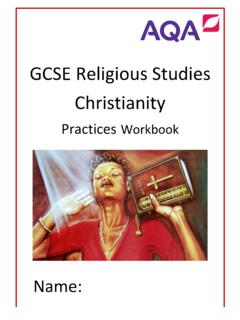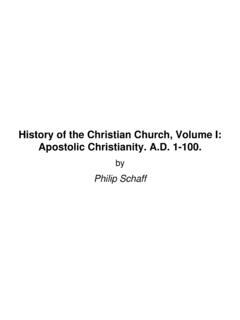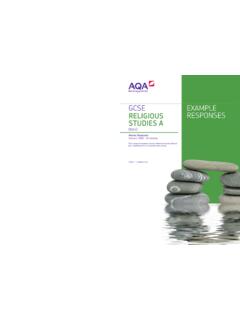Transcription of GCSE RELIGIOUS STUDIES 8063/1
1 ADDITIONAL SPECIMEN MATERIAL: SET 2 GCSE RELIGIOUS STUDIES 8063/1 CATHOLIC christianity Mark scheme Additional specimen MARK SCHEME GCSE RELIGIOUS STUDIES B 8063/1 ADDITIONAL SPECIMEN Mark schemes are prepared by the Lead Assessment Writer and considered, together with the relevant questions, by a panel of subject teachers. This mark scheme includes any amendments made at the standardisation events which all associates participate in and is the scheme which was used by them in this examination. The standardisation process ensures that the mark scheme covers the students responses to questions and that every associate understands and applies it in the same correct way. As preparation for standardisation each associate analyses a number of students scripts. Alternative answers not already covered by the mark scheme are discussed and legislated for. If, after the standardisation process, associates encounter unusual answers which have not been raised they are required to refer these to the Lead Assessment Writer.
2 It must be stressed that a mark scheme is a working document, in many cases further developed and expanded on the basis of students reactions to a particular paper. Assumptions about future mark schemes on the basis of one year s document should be avoided; whilst the guiding principles of assessment remain constant, details will change, depending on the content of a particular examination paper. Further copies of this mark scheme are available from 2 MARK SCHEME GCSE RELIGIOUS STUDIES B 8063/1 ADDITIONAL SPECIMEN Level of response marking instructions Level of response mark schemes are broken down into levels, each of which has a descriptor. The descriptor for the level shows the average performance for the level. There are marks in each level. Before you apply the mark scheme to a student s answer read through the answer and annotate it (as instructed) to show the qualities that are being looked for. You can then apply the mark scheme. Step 1 Determine a level Start at the lowest level of the mark scheme and use it as a ladder to see whether the answer meets the descriptor for that level.
3 The descriptor for the level indicates the different qualities that might be seen in the student s answer for that level. If it meets the lowest level then go to the next one and decide if it meets this level, and so on, until you have a match between the level descriptor and the answer. With practice and familiarity you will find that for better answers you will be able to quickly skip through the lower levels of the mark scheme. When assigning a level you should look at the overall quality of the answer and not look to pick holes in small and specific parts of the answer where the student has not performed quite as well as the rest. If the answer covers different aspects of different levels of the mark scheme you should use a best fit approach for defining the level and then use the variability of the response to help decide the mark within the level, ie if the response is predominantly level 3 with a small amount of level 4 material it would be placed in level 3 but be awarded a mark near the top of the level because of the level 4 content.
4 Step 2 Determine a mark Once you have assigned a level you need to decide on the mark. The descriptors on how to allocate marks can help with this. The exemplar materials used during standardisation will help. There will be an answer in the standardising materials which will correspond with each level of the mark scheme. This answer will have been awarded a mark by the Lead Examiner. You can compare the student s answer with the example to determine if it is the same standard, better or worse than the example. You can then use this to allocate a mark for the answer based on the Lead Examiner s mark on the example. You may well need to read back through the answer as you apply the mark scheme to clarify points and assure yourself that the level and the mark are appropriate. Indicative content in the mark scheme is provided as a guide for examiners. It is not intended to be exhaustive and you must credit other valid points. Students do not have to cover all of the points mentioned in the Indicative content to reach the highest level of the mark scheme.
5 An answer which contains nothing of relevance to the question must be awarded no marks. Levels of response marking In GCSE RELIGIOUS STUDIES , differentiation is largely achieved by outcome on the basis of students responses. To facilitate this, levels of response marking has been devised for many questions. Levels of response marking requires a quite different approach from the examiner than the traditional point for point marking. It is essential that the whole response is read and then allocated to the level it best fits. If a student demonstrates knowledge, understanding and / or evaluation at a certain level, he / she must be credited at that level. Length of response or literary ability should not be confused with genuine 3 MARK SCHEME GCSE RELIGIOUS STUDIES B 8063/1 ADDITIONAL SPECIMEN RELIGIOUS STUDIES skills. For example, a short answer which shows a high level of conceptual ability must be credited at that level. (If there is a band of marks allocated to a level, discrimination should be made with reference to the development of the answer.)
6 Levels are tied to specific skills. Examiners should refer to the stated assessment target objective of a question (see mark scheme) when there is any doubt as to the relevance of a student s response. Levels of response mark schemes include either examples of possible students responses or material which they might use. These are intended as a guide only. It is anticipated that students will produce a wide range of responses to each question. It is a feature of levels of response mark schemes that examiners are prepared to reward fully, responses which are obviously valid and of high ability but do not conform exactly to the requirements of a particular level. This should only be necessary occasionally and where this occurs examiners must indicate, by a brief written explanation, why their assessment does not conform to the levels of response laid down in the mark scheme. Such scripts should be referred to the Principal Examiner. In questions where credit can be given to the development of a point, those developments can take the form of: Example or evidence Reference to different views Detailed information.
7 4 MARK SCHEME GCSE RELIGIOUS STUDIES B 8063/1 ADDITIONAL SPECIMEN Spelling, Punctuation and Grammar (SPaG) Spelling, punctuation and grammar will be assessed in 12-mark questions. 5 MARK SCHEME GCSE RELIGIOUS STUDIES B 8063/1 ADDITIONAL SPECIMEN 01 INCARNATION Qu Part Marking guidance Total marks 01 1 Which one of the following is the meaning of the statement people are made in the image of God (imago dei) ? A People look the same as God. B People share the qualities of God. C People have little value as they are not God. D People experience the presence of God. Target: AO1:1 Demonstrate knowledge and understanding of religion and belief, including beliefs, practices and sources of authority. Answer: B People share the qualities of God. 1 01 2 Give two Catholic beliefs about the importance of the life of the unborn child. Target: AO1:1 Demonstrate knowledge and understanding of religion and belief, including beliefs, practices and sources of authority.
8 One mark for each of two correct points. Life begins at conception/the individual is present from the start of life/ even in the womb the baby is aware and reacts/this is seen in the account of the Visitation when Jesus was recognised though he had only recently been conceived/and in the fact that John the Baptist was just over six months in the womb but responded to the presence of Jesus/life in the womb should be recognised and supported, etc. 2 6 MARK SCHEME GCSE RELIGIOUS STUDIES B 8063/1 ADDITIONAL SPECIMEN 01 3 Explain two ways in which beliefs about the incarnation have influenced Catholic views about RELIGIOUS art. Target: AO1:2 Knowledge and understanding of religion and belief: influence on individuals, communities and societies. First way Simple explanation of a relevant and accurate way 1 mark Detailed explanation of a relevant and accurate way 2 marks Second way Simple explanation of a relevant and accurate way 1 mark Detailed explanation of a relevant and accurate way 2 marks Students may include some of the following points, but all other relevant points must be credited.
9 Since God limited himself in a human form, God and Jesus can be shown in a human form/ RELIGIOUS art is not attempting to put limits on God but to remind people that God became incarnate God commanded that humans should not make images of anything in heaven or earth and worship them/but since God has appeared in flesh this rule does not apply to art such as statues of God or saints/as long as people do not worship the statue but only God himself as God became man for all people, it does not matter how Jesus is shown in RELIGIOUS art/as what is important is the fact of the Incarnation, not any attempt to give a true portrait of Jesus/nobody knows what Jesus looked like etc. 4 7 MARK SCHEME GCSE RELIGIOUS STUDIES B 8063/1 ADDITIONAL SPECIMEN 01 4 Explain two Christian beliefs about the Incarnation. Refer to scripture or another source of Christian belief and teaching in your answer. Target: AO1:1 Demonstrate knowledge and understanding of religion and belief, including beliefs, practices and sources of authority.
10 First belief Simple explanation of a relevant and accurate belief 1 mark Detailed explanation of a relevant and accurate belief 2 marks Second belief Simple explanation of a relevant and accurate belief 1 mark Detailed explanation of a relevant and accurate belief 2 marks Relevant and accurate reference to teaching 1 mark Students may include some of the following points, but all other relevant points must be credited: Jesus is the Word of God made flesh/references to John 1/in him, God has spoken his final word to humanity/Jesus came to free human beings from their slavery to sin/humans can see the love of God in the person and actions of Jesus the eternal Word became small for us, small enough to fit in a manger /Jesus accepted the limits of the human condition, but at all times he did the will of God/it was in the human act of dying that Jesus completely gave himself to God the Father the eternal Word shows people what God is like/ whoever has seen me has seen the Father /the qualities that people value in Jesus are the qualities of God/humans can share these qualities but sin often damages them/since Jesus did not sin, these qualities are not damaged in him, etc.













